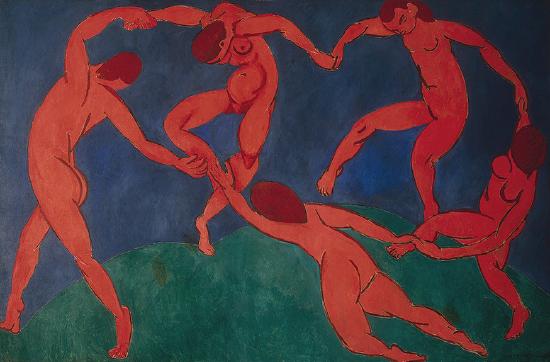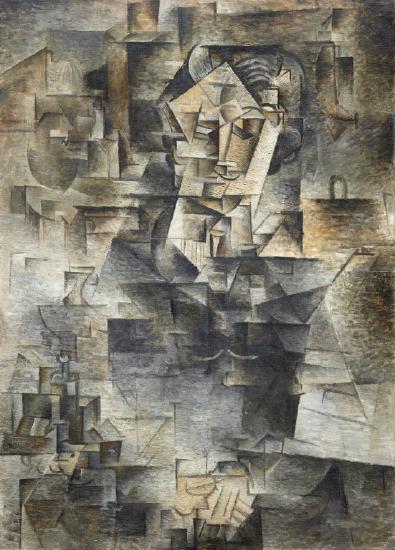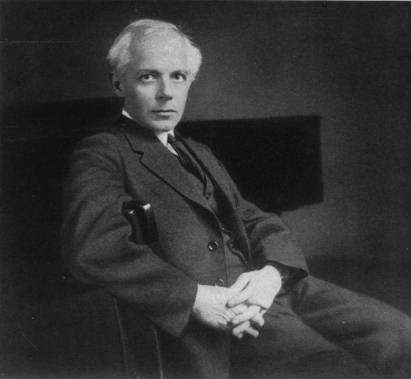6.3: Early 20th Century Modernism
- Page ID
- 165645
Early 20th Century Modernism.

Henri Matisse, la danse (1910). State Hermitage Museum, Saint Petersburg, Russia, Public Domain-US.
The term "modernism" is a term that typically refers to the artistic movement of the late 19th and early 20th centuries where artists pushed the boundaries of tradition, seeking innovative and new ways of expression through their medium. This could be done in a number of different ways, and there are many different "types" of modernism. The above painting by Henri Matisse shows an interesting approach, and depicts the artist's fascination with primitivism. The lack of depth and detail almost look like an amateur's painting, but this was a significant departure in the realistic paintings that saturated the 19th century.

Now look at the painting to the right, Pablo Picasso's Portrait of Daniel-Henry Kahnweiler from 1910—the same year as Matisse's painting. It's quite different, and embodies the artistic style known as cubism, which depicts an image through a variety of distorted-looking cubes. If you look closely, you'll be able to see a person's face in the upper center of the painting; their hands are folded on the bottom of the canvas.
Both of these paintings are but a small glimpse into what modernism can look like.
While these paintings are both radically different from one another, and from the realistic paintings from the 19th century, they do have something else in common: they both hold onto some form of the tradition that came before it. In other words, the paintings are innvotive, new, and maybe even "offensive" to the sensibilities of the traditionalists, but they still employ traditional compositional techniques.
For instance, although Picasso's painting is radically different, its subject matter is still a person's portrait. Moreover, you can still make out a person within the painting, distorted as it may be.
This is a key difference between modernists and post-modernists.
Modernists tend to be innovative, new, and radically different, while still holding on to some form of traditional techniques. The post-modernists or Avant-garde takes a different approach, often acting as revolutionaries while thumbing their nose at tradition.
We see modernism in music as well. Many comopsers of the early 20th century can be considered modernists if they pushed the boundaries through radically different and "progressive" techniques, while still holding on to some traditional techniques. The composer we'll look at in this unit is Bela Bartok.
(above): Portrait of Daniel-Henry Kahnweiler by Pablo Picasso - Website of the Art Institute of Chicago, Public Domain-US.
Béla Bartok (1881-1945)
 Béla Bartók was an Hungarian composer whose compositional output included many modernist techniques. He was a very talented and skilled pianist of his day, and from an early age was interested in folk music of different cultures. Often, he would insert well-known folk melodies from Hungary and other Eastern-European countries into his own instrumental music. This is known as quotation--inserting something that one didn't write themselves into their own music. Sometimes, his own music sounded like folk tunes, because he would write melodies in the same style of much of the music he liked!
Béla Bartók was an Hungarian composer whose compositional output included many modernist techniques. He was a very talented and skilled pianist of his day, and from an early age was interested in folk music of different cultures. Often, he would insert well-known folk melodies from Hungary and other Eastern-European countries into his own instrumental music. This is known as quotation--inserting something that one didn't write themselves into their own music. Sometimes, his own music sounded like folk tunes, because he would write melodies in the same style of much of the music he liked!
Bartok was so interested in folk music that prior to World War I, Bartok traveled to different regions within Eastern Europe, and collected different melodies from the townspeople. He traveled with an Edison Phonograph, and would have different people come up to the machine to sing their melodies while he recorded them. He collected traditional Hungarian, Romanian, Slovak, Bulgarian, and Algerian folk tunes, and would then transcribe the music that he recorded onto sheet music. In some instances, he arranged the music for beginning pianists to learn, and in other cases, he would incorporate some of the melodies into his own compositions.
As one of the first people to travel to other countries and collect their music, Bartok is known as one of the founders of comparative ethnomusciology - that is, the cross-cultural study of music. This is subset of ethnomusicology, which studies music from a cultural perspective.
(above): picture of Béla Bartók, Public Domain.

The picture on the right shows Bartok during his travels before World War I erupted. Here, Bartok has a woman singing a folk tune that she grew up with into his phonograph machine, which records the melodies onto a wax cylinder recording machine invented by Thomas Edison.
Even in Bartok's most modernist compositions, he would often sneak some quotations of folk melodies into his music; this was a subtle way of paying homage to different cultures and heritages, while simultaneously helping those who might find his music difficult to listen to more easily appreciate and latch onto his music.
The video presentation on Bartok and his approach to Modernism discusses the music Out of Doors, which is a short collection of 5 different piano pieces composed in 1926. As the name suggests, it's named after things that one might hear if they were outside.
There is a PDF handout for this particular piece that is also found in the presentation. For readers who would like a copy of the handout, they may download it on this page.
(right): Bartok (fourth from left) records a woman singing a folk tune in modern-day upper Hungary. Public Domain.
Bartok's Piano Suite: Out of Doors
Composed in 1926, Bartok's Out of Doors contains 5 short movements, each with a title that makes one think of being outside:
I. “With Pipes and Drums”
II. “Musettes”
III. “Barcarolla”
IV. “The Night’s Music”
V. “The Chase”
The piece Out of Doors is a perfect example of 20th century modernism. Bartok explores the many different ways of making sound on piano, sometimes treating it like a drum kit! Take a listen to the opening of the 1st movement here, and you'll see that the pianist is "banging" the lowest two notes on the piano, creating a drum effect. This is immediately followed by a melody that's loosely based off of a pre-existing folk melody that was popular during his time. It therefore combines a radically dissonant "drumming" effect with traditional melodic writing -- a great example of the modernist technique in action.
Listen to the 4th movement, "The Night's Music," which is a great example of Bartok's fascination with insect sounds. He actually tried to imitate the sounds of bugs and other insects in much of his music (similar to Messiaen's fascination with bird calls, but Bartok predates Messiaen by several decades!) The "Night's Music" contains a bunch of random fragments of piano sounds that imitate cicadas, bull frogs, owls, mice scampering, and other sounds you might hear at night. These insect sounds are interrupted by melodic fragments that almost sounds like folk music and dances. Formally, the music is broken into a "rondo" form, creating an ABACABA structure. Again, it's a great representative of the modernist style, combining radically dissonant and innovative writing techniques with traditional melodies and form.
The last movement, "The Chase," is quick, fast, violent, and fun. It resembles two animals chasing one another in the woods, until finally one is eventually caught!
The handout provided in this page includes more information on all 5 movements of this piece, and is covered in the video presentation.

